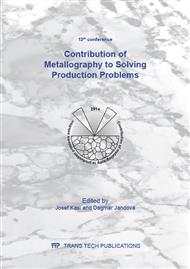p.115
p.121
p.131
p.141
p.147
p.153
p.162
p.173
p.180
Heterogeneous Welded Joints (T23-T92; 15CH1M1F-P91)
Abstract:
The use of new construction materials is increasingly on demand for the construction of new power plants, and for the modernization of existing plants that are at the end of their service life span. Steels such as type P/T92 (modified martensitic 9-12% Cr), and low-alloy steels derived from modified steel 2.5Cr1Mo (ASTM marked P/T23) are considered promising alternatives. In the construction of power units, the so-called heterogeneous joints, which most often consist of a combination of low-alloyed materials and highly-alloyed ones, preferably need to be avoided. These welded joints are often the weak links in the overall construction. Knowledge of the behaviour of creep-resistant steel welded joints is very important for the subsequent evaluation of the life span of the units. This study deals with the degradation of heterogeneous welded joints of steel T23 - T92 and 15CH1M1F - P91, using the commercially available welding materials Thermanit MTS 616 (highly-alloyed), Union I P23; ThermanitP23, Böhler P23-IG and Thermanit (FOX) P23 (low-alloyed). In the heterogeneous welds examined, slight loss of strength of the base material was observed during isothermal heat exposure and extension of the diffusion active zones (i.e., Carbon Depleted Zone (CDZ) and Carbon Enriched Zone (CEZ)). These degradation processes caused structural instability of heterogeneous welds. It was found that the use of low-alloyed welding materials showed superior structural stability than highly-alloyed welds. Additional laboratory analyses are warranted due to the extreme service conditions and the high temperature loads in power units.
Info:
Periodical:
Pages:
147-152
Citation:
Online since:
May 2015
Authors:
Price:
Сopyright:
© 2015 Trans Tech Publications Ltd. All Rights Reserved
Share:
Citation:


